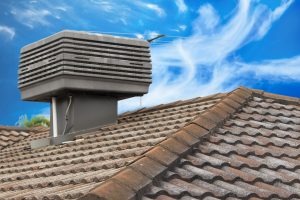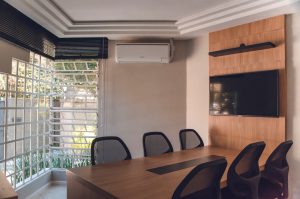A comfortable humidity level may be fairly obvious from the standpoint of what feels comfortable for you and your family but there are other considerations of which you should be aware. If you are looking for the ideal indoor humidity, there are many factors to consider. Let’s get started by learning a bit more about humidity and its effects on your environment.
To achieve the best humidity level for your household, you must first understand what humidity is, how it affects you and your home and what you can do to control it. Armed with a bit of knowledge, you can achieve the appropriate humidity level and air quality for your household and maintain it without too much effort.
What is Humidity?
With the rise and fall of temperatures, the air’s capacity to hold water shifts and changes. Warmer air can hold more water, while cooler air holds less water. The relative humidity is a measure of the water vapor that is present in the air in relation to what is required for full saturation at the same temperature. This is reflected as a percentage. Thus, a 50% humidity level means the air is holding half of what it is capable of holding at the same temperature.
Ideal Indoor Humidity
The question for most homeowners is how humid should your house be. The ideal indoor humidity ranges between 30-45%, though it may sometimes reach as high as 50%. The level of humidity you experience in your home can depend largely on the seasons. Summer humidity should be in the normal range of 30-45%, but winter humidity may hover around the 40% mark. Anything greater than this can lead to condensation issues within your home.
Your inside house humidity can also depend on your home layout, your routine, and your personal preferences. The American Society of Heating, Refrigerating and Air-Conditioning Engineers (ASHRAE) lists the following levels for most homes:
- 30%-60%: Comfortable
- 45%-55%: Recommended
- 65%-80%: High
So, a comfortable range for the humidity in your home can fall anywhere from 30% to 60%. Anything below 30% is too dry and anything greater than 60% is too humid. However, you should be aware that humidity levels that are persistently above 50% can enable the growth of bacteria.
Comfortable humidity indoors, just as the temperature you prefer, is largely a personal preference. The weather, season, location and even the materials you prefer in your clothing can all factor into what humidity you find comfortable.
Humidity and Personal Well-Being
Humidity is what keeps you cool during the warmer months and warm during the cooler months. High humidity on hot summer days is what causes you to perspire even when inactive. Excessive humidity can not only cause discomfort but can also lead to illness and disease. Maintaining acceptable home humidity levels will keep you healthy, even if you are periodically exposed to higher levels outside.
The benefits of proper humidity levels in your home include:
- Clear sinuses
- Fewer infections due to the reduced presence of bacteria
- Skin retains more moisture
- Reduced snoring due to a lack of excess moisture in the respiratory systems
- Better sleep due to fewer problems with a dry or sore throat
- Reduced fatigue due to better absorption and processing of oxygen
Effects of High Humidity on Your Home
Acceptable humidity levels will also protect the interior of your home. Paintings and photos won’t risk damage. You won’t risk arcing and short circuits due to damaged electrical wires and cables. Wooden furniture and fixtures won’t be subject to warping or damage. Perhaps the most noticeable effect of high humidity in your home is the condensation you will see on walls, furniture, and windows.
The excessive moisture brought on by high humidity fosters the growth of mold, mildew, and fungi which can spread rapidly, bringing with them contamination that can cause illness to everyone in the household, especially those with allergies, asthma, or other respiratory problems. The increased moisture that comes along with high humidity can have greatly increased adverse effects on these ailments.
Effects of Low Humidity on Your Home
Just as high humidity can be a breeding ground for virus-producing bacteria, low humidity can also be a catalyst for airborne viruses. In addition to the potential for illness, low humidity results in dry air that causes chapped lips, flaky skin, and rashes. You might also feel considerably cooler than you should because dry air takes away moisture from your skin. This will result in you adjusting the temperature unnecessarily and increasing your utility bills.
The effects of low humidity on your wooden furniture, crown molding, door frames, and window frames are also unfortunate. Persistent low humidity and dry air in your home can cause furniture and fixtures to splinter and crack.
Controlling Home Humidity
You may not need to take active measures. In some households, your HVAC system will do all the work for you and you’ll never have to think about your home humidity level. However, if your air conditioner is cooling your home, but not removing humidity, and you don’t have the natural balance you need, you can employ additional measures such as these:
- Humidifiers put moisture into the air, increasing your humidity
- Dehumidifiers to reduce moisture in the air, decreasing your humidity
- Exhaust fans to remove excess humidity in the air from activities such as steam from showers or cooking
- Phone apps that monitor humidity and adjust compatible smart and programmable thermostats, such as those that control mini-split units
- Vapor barriers to seal off clay, dirt, or other partially porous foundations in older homes that can absorb moisture and increase humidity in areas such as your basement or cellar
Conclusion
Hopefully understanding the principles of relative humidity, its effects on you and your home, and how to make the adjustments you need to in order to keep it at optimal levels, will help keep you more comfortable and give you the tools you need to stay healthy and happy. In addition to these considerations, a comfortable humidity level will result in lower utility bills and allow you to run your air conditioning and heating at more energy-efficient levels.














